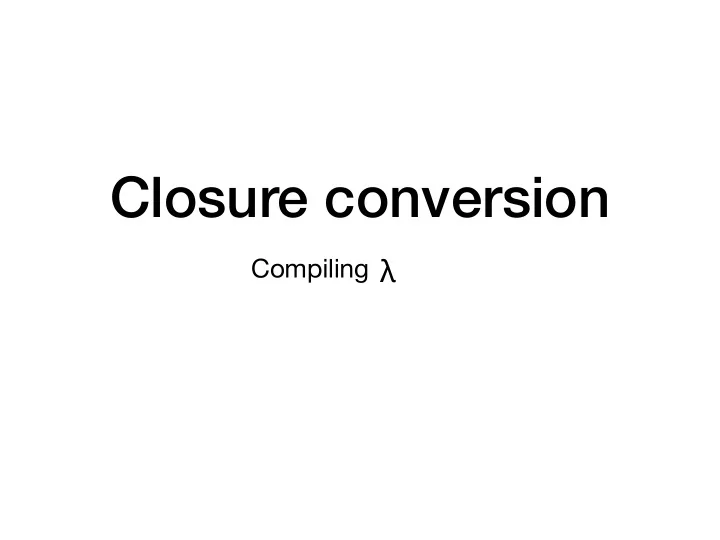

Closure conversion Compiling λ
try, finally, dynamic-wind raise, guard let loop, for, while continue, break Call/cc, call/ec, return λ threads, coroutines Function calls closure objects (code ptr, environment)
Closure conversion • In strict CPS, lambdas no longer return. • Function calls are just first-class goto ’s that take arguments and carry values for free variables in an environment. • Closure conversion: • Hoists all functions to the top-level. • Allocates closures that save the current environment. • Function calls explicitly pass the closure’s env. • Replaces references to free variables with env access.
Closure conversion ( λ (a b) …) new Lambda43(x,y,z); class Lambda43 : public Lam { private: FV ( ( λ (a b) …) ) const u64 x,y,z; public: = {x,y,z} Lambda43(u64 x, u64 y, u64 z) : x(x), y(y), z(z) {} u64 apply(u64 a, u64 b) { … } };
Closure conversion Lambda43::apply vtable* x class Lambda43 : public Lam y { private: z const u64 x,y,z; public: Lambda43(u64 x, u64 y, u64 z) : x(x), y(y), z(z) {} u64 apply(u64 a, u64 b) { … } };
Closure conversion: two principal strategies • Top-down closure conversion: • Traverses the AST and turns lambdas into closures on the way down (computing environments as it goes). • Produces linked environments/closures . • Pros: compact, shared environments; Cons: slower. • Bottom-up closure conversion: • Traverses the AST and turns lambdas into closures on the way back up (computing free vars as it goes). • Produces flat environments/closures . • Pros: fast, computes free vars; Cons: more copying.
… ( λ (a) … ( λ (b c) … ( λ (d) … (f a c) …) …) …) …
Top-down closure conversion • As the AST is traversed, a set of locally bound variables are computed. • A map from non-locally bound variables to their access expressions is maintained so that variables can be looked up in an environment. • At each lambda: the algorithm lifts the lambda to a first- order C-like procedure, allocates a new closure and its environment, then converts it’s body using an updated map for non-locally bound variables (with paths into this newly defined environment). • Previously allocated environment is linked-to/shared.
… ( λ (a) bound vars: x … ( λ (b c) … ( λ (d) … (f a c) …) …) …) …
(proc (lam0 env0 a) (proc (main) … … (vector ( λ (b c) lam0 … (prim vector ( λ (d) x)) … …) (f a c) …) …) …) env mapping: x -> (vector-ref env0 ‘0)
(proc (lam0 env0 a) (proc (main) … … (prim vector (prim vector lam0 lam1 (prim vector (prim vector x)) env0 …) a y)) …) (proc (lam1 env1 b c) bound vars: env0,a,y … env mapping: ( λ (d) x -> (vector-ref env0 ‘0) … env0 -> (vector-ref env1 ‘0) a -> (vector-ref env1 ‘1) (f a c) y -> (vector-ref env1 ‘2) …) …)
Bottom-up closure conversion • As the AST is traversed, free variables are computed. • At each lambda: 1) the algorithm converts any lambdas under the lambda’s body first (and also computes a set of free variables); then 2) it emits code to allocate the lambda’s closure/environment and replaces free vars with env access. • Converting the body of a lambda yields a set of free variables that can be canonically ordered . • Closures are flat heap-allocated vectors containing a function pointer and then each free var in order . • Accesses of free variables are turned into a vector-ref with the predetermined index.
… ( λ (a) … ( λ (b c) … ( λ (d) … free vars: a,c,f (f a c) …) …) …) …
(proc (lam14 env d) … … ( λ (a) (clo-app … (prim vector-ref env ‘3) ;f (prim vector-ref ( λ (b c) env ‘1) ;a … (prim vector-ref env ‘2)) ;c …) adds first-order proc (prim vector lam14 a c allocates flat closure f) …) …) …) …
… ( λ (a) … ( λ (b c) … (prim vector lam14 free vars: a f x y a { c f) references at closure allocation can remain free …) …) …) …
(clo-app (prim vector-ref env ‘3) ;f (prim vector-ref env ‘1) ;a (prim vector-ref env ‘2)) ;c (let ([f-clo (prim vector-ref env ‘3)]) (let ([f-ptr (prim vector-ref f-clo ‘0)]) (let ([a (prim vector-ref env ‘1)]) (let ([c (prim vector-ref env ‘2)]) (C-style-call f-ptr f-clo a c))))) application: 1) function pointer is accessed from closure 2) closure ( f-clo ) is passed to invoked function ptr
Let’s live code bottom-up closure conversion.
Recommend
More recommend